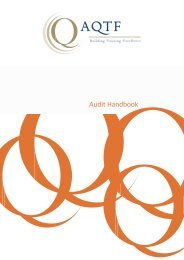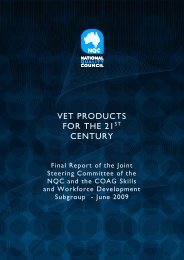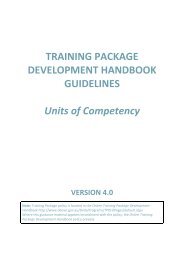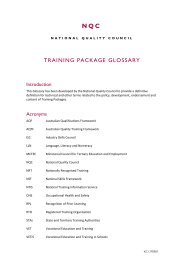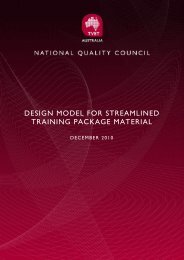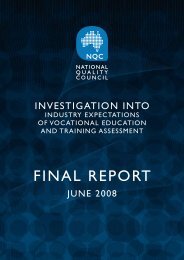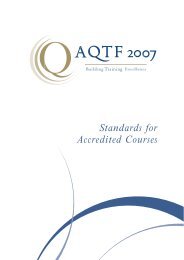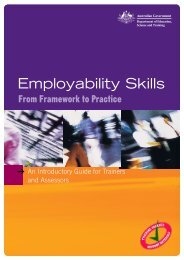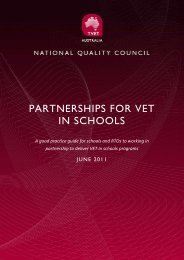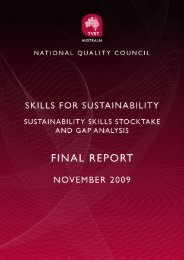Standards for Training Packages - National Skills Standards Council ...
Standards for Training Packages - National Skills Standards Council ...
Standards for Training Packages - National Skills Standards Council ...
- No tags were found...
You also want an ePaper? Increase the reach of your titles
YUMPU automatically turns print PDFs into web optimized ePapers that Google loves.
NATIONALNATIONALSKILLSSKILLSSTANDARDSSTANDARDSCOUNCILCOUNCILSTANDARDS FORTRAINING PACKAGESNSSCNATIONALSKILLSSTANDARDSCOUNCIL
This document is one of three products that <strong>for</strong>m the organising framework of standards that support thedevelopment of industry <strong>Training</strong> <strong>Packages</strong>.The <strong>Standards</strong> <strong>for</strong> <strong>Training</strong> <strong>Packages</strong> were endorsed by the Standing <strong>Council</strong> on Tertiary Education, <strong>Skills</strong> andEmployment on 16 November 2012.The <strong>Standards</strong> <strong>for</strong> <strong>Training</strong> <strong>Packages</strong> and their underpinning policies can be found on the NSSC website:www.nssc.natese.gov.au/training_packagesThe organising framework of standards includes:• NSSC - <strong>Standards</strong> <strong>for</strong> <strong>Training</strong> <strong>Packages</strong>• NSSC - <strong>Training</strong> Package Products Policy• NSSC - <strong>Training</strong> <strong>Packages</strong> Development and Endorsement Process PolicyVersion: 1.0© 2012 Commonwealth of AustraliaWith the exception of the NATESE and NSSC Logos, any material protected by a trademark and where otherwisenoted, all material presented in this document is provided under a Creative Commons Attribution 3.0 Australialicense: http://creativecommons.org/licenses/by/3.0/au/The details of the relevant license conditions are available on the Creative Commons website as is the full legal code<strong>for</strong> the CC BY 3.0 AU license: http://creativecommons.org/licenses/by/3.0/au/legalcodeThe document must be attributed as the NSSC - <strong>Standards</strong> <strong>for</strong> <strong>Training</strong> <strong>Packages</strong>.Page 2NSSC - <strong>Standards</strong> <strong>for</strong> <strong>Training</strong> <strong>Packages</strong>
<strong>Standards</strong> <strong>for</strong> <strong>Training</strong> <strong>Packages</strong>Purpose of the <strong>Standards</strong>The purpose of the <strong>Standards</strong> <strong>for</strong> <strong>Training</strong> <strong>Packages</strong>is to ensure <strong>Training</strong> <strong>Packages</strong> are of high quality andmeet the work<strong>for</strong>ce development needs of industry,enterprises and individuals.The <strong>Standards</strong> <strong>for</strong> <strong>Training</strong> <strong>Packages</strong> apply to the designand development of <strong>Training</strong> <strong>Packages</strong> <strong>for</strong> endorsementconsideration by the <strong>National</strong> <strong>Skills</strong> <strong>Standards</strong> <strong>Council</strong>(NSSC).<strong>Training</strong> <strong>Packages</strong> - productsStandard 1: <strong>Training</strong> <strong>Packages</strong> consist of the following:1. NSSC endorsed components:• units of competency;• assessment requirements (associated with each unit ofcompetency);• qualifications; and• credit arrangements.2. One or more quality assured companion volumes.<strong>Training</strong> <strong>Packages</strong> - policyStandard 2: <strong>Training</strong> Package developers comply withthe NSSC <strong>Training</strong> Package Products Policy.Standard 3: <strong>Training</strong> Package developers complywith the NSSC <strong>Training</strong> Package Development andEndorsement Process Policy.<strong>Training</strong> <strong>Packages</strong> - componentsUnits of CompetencyStandard 4: Units of competency specify the standardsof per<strong>for</strong>mance required in the workplace..Standard 5: The structure of units of competencycomplies with the unit of competency template.Assessment RequirementsStandard 6: Assessment requirements specify theevidence and required conditions <strong>for</strong> assessment.Standard 7: Every unit of competency has associatedassessment requirements. The structure of assessmentrequirements complies with the assessmentrequirements template.QualificationsStandard 8: Qualifications comply with the AustralianQualifications Framework specification <strong>for</strong> thatqualification type.Standard 9: The structure of the in<strong>for</strong>mation <strong>for</strong> theAustralian Qualifications Framework qualificationcomplies with the qualification template.Credit ArrangementsStandard 10: Credit arrangements existing between<strong>Training</strong> Package qualifications and Higher Educationqualifications are listed in a <strong>for</strong>mat that complies withthe credit arrangements template.Companion VolumesStandard 11: A quality assured companionvolume implementation guide produced by the<strong>Training</strong> Package developer is available at the timeof endorsement and complies with the companionvolume implementation guide template.Standard 12: <strong>Training</strong> Package developers produceother quality assured companion volumes to meet theneeds of their stakeholders as required.NSSC - <strong>Standards</strong> <strong>for</strong> <strong>Training</strong> <strong>Packages</strong>Page 3
Unit of Competency TemplateUNIT CODEMANDATORY FIELDUNIT TITLEMANDATORY FIELDAPPLICATIONMANDATORY FIELDThe unit code contains the three alpha characters identifying the <strong>Training</strong> Package,followed by alpha and/or numeric characters. It must comply with the lengthspecified in the AVETMIS Standard (no more than 12 characters).The title concisely describes the unit outcome.It must comply with the length specified in the AVETMIS Standard (no more than100 characters)The application section briefly describes how the unit is practically applied in theindustry and in what context(s) the unit may be applied. It Includes:• a summary statement of unit content;• focused, useful in<strong>for</strong>mation on how and where the unit of competency could bepractically applied and who might use it; and• the unit of competency’s relationship to any licensing, legislative, regulatory orcertification requirements. Where no requirements exist, insert:PREREQUISITE UNITOPTIONAL FIELDCOMPETENCY FIELDOPTIONAL FIELDUNIT SECTOROPTIONAL FIELDELEMENTSMANDATORY FIELDElements describe the essentialoutcomes.1. Elements describe actions oroutcomes that are demonstrableand assessable.FOUNDATION SKILLSMANDATORY FIELDNo licensing, legislative or certification requirements apply to this unit at the timeof publication.List any unit(s) in which the candidate must be deemed competent prior to thedetermination of competency in this unit.Used only when the <strong>Training</strong> Package developer wishes to categorise a set of unitswithin a <strong>Training</strong> Package in relation to a type of work.Used only when the <strong>Training</strong> Package developer wishes to categorise a set of unitswithin a <strong>Training</strong> Package in relation to an industry sector.PERFORMANCE CRITERIAMANDATORY FIELDPer<strong>for</strong>mance criteria describe the per<strong>for</strong>mance needed to demonstrateachievement of the element.1.1 Per<strong>for</strong>mance criteria clearly relate to the element.1.2 They are expressed as a standard.1.3 They specify the required per<strong>for</strong>mance in relevant tasks, roles, and skills.1.4 They reflect the applied knowledge that enables competent per<strong>for</strong>mance.This section describes those language, literacy, numeracy and employment skills that are essential to per<strong>for</strong>mance.Foundation skills essential to per<strong>for</strong>mance in this unit, but not explicit in the per<strong>for</strong>mance criteria are listed here, along with abrief context statement.Where all foundation skills essential to per<strong>for</strong>mance in this unit are explicit in the per<strong>for</strong>mance criteria insert:Foundation skills essential to per<strong>for</strong>mance are explicit in the per<strong>for</strong>mance criteria of this unit of competency.RANGE OF CONDITIONSOPTIONAL FIELDSpecifies different work environments and conditions that may affect per<strong>for</strong>mance. Essential operating conditions that maybe present (depending on the work situation, needs of the candidate, accessibility of the item, and local industry and regionalcontexts) are included.Range is restricted to essential operating conditions and any other variables essential to the work environment.UNIT MAPPING INFORMATIONMANDATORY FIELDLINKSMANDATORY FIELDMandatory Fields are HighlighedSpecifies code and title of any equivalent unit of competency.If no equivalent insert:No equivalent unit.Link to Companion Volume Implementation Guide.Page 4NSSC - <strong>Standards</strong> <strong>for</strong> <strong>Training</strong> <strong>Packages</strong>
Assessment Requirements TemplateTITLEMANDATORY FIELDPERFORMANCE EVIDENCEMANDATORY FIELDKNOWLEDGE EVIDENCEMANDATORY FIELDASSESSMENT CONDITIONSMANDATORY FIELDLINKSMANDATORY FIELDAssessment Requirements <strong>for</strong> [insert Unit of Competency Code and Title]• specifies the required product and process evidence.• specifies the frequency and/or volume of product/process evidence.• specifies the relationship between the product and process evidence and theper<strong>for</strong>mance criteria.• specifies what the individual must know in order to safely and effectivelyper<strong>for</strong>m the work task described in the unit of competency.• relates directly to the per<strong>for</strong>mance criteria and/or range of conditions.• indicates the type and depth of knowledge required to meet the demands ofthe unit of competency.• stipulates any mandatory conditions <strong>for</strong> assessment.• specifies the conditions under which evidence <strong>for</strong> assessment must begathered, including any details of equipment and materials, contingencies,specifications, physical conditions, relationships with team members andsupervisor, relationship with client/customer, and timeframe.• specifies assessor requirements, including any details related to qualifications,experience and industry currency.Link to Companion Volume Implementation Guide.Mandatory Fields are HighlighedNSSC - <strong>Standards</strong> <strong>for</strong> <strong>Training</strong> <strong>Packages</strong>Page 5
Qualification TemplateQUALIFICATION CODEMANDATORY FIELDQUALIFICATION TITLEMANDATORY FIELDQUALIFICATION DESCRIPTIONMANDATORY FIELDENTRY REQUIREMENTSOPTIONAL FIELDPACKAGING RULESMANDATORY FIELDQUALIFICATION MAPPINGINFORMATIONMANDATORY FIELDLINKSMANDATORY FIELDThe qualification code contains the three alpha characters identifying the<strong>Training</strong> Package, a numeric character identifying the AQF level, a two numericcharacter sequence identifier, and two numeric characters identifying the yearthe qualification was endorsed. It must comply with the length specified in theAVETMIS Standard.A unique title that reflects the qualification outcome. It must comply with thelength specified in the AVETMIS Standard (no more than 100 characters).A description of the qualification outcomes.Any licensing, legislative, regulatory or certification considerations. Where noneexist insert:No licensing, legislative or certification requirements apply to this qualification at thetime of publication.Specifies any mandatory entry requirementsSpecifies the total number of units of competency required to achieve thequalification.Specifies the number of core and elective units.Lists all core and elective unit codes and titles, including prerequisite units wherethey apply.Specifies code and title of any equivalent qualification.If no equivalent insert:No equivalent qualification.Link to Companion Volume Implementation Guide.Mandatory Fields are HighlighedPage 6NSSC - <strong>Standards</strong> <strong>for</strong> <strong>Training</strong> <strong>Packages</strong>
Credit Arrangements TemplateCREDIT ARRANGEMENTS FOR [insert <strong>Training</strong> Package Code and Title]MANDATORY FIELDQUALIFICATION CODEMANDATORY FIELDQUALIFICATION TITLEMANDATORY FIELDCREDIT ARRANGEMENTDETAILSMANDATORY FIELDSpecifies existing credit arrangementsbetween <strong>Training</strong> Package qualificationsand Higher Education qualifications inaccordance with the AQF.Where there are no direct creditarrangements in place the followingstatement is inserted here:At the time of endorsement of this<strong>Training</strong> Package no national creditarrangements exist.LINKSMANDATORY FIELDLink to Companion Volume Implementation Guide.Mandatory Fields are HighlighedNSSC - <strong>Standards</strong> <strong>for</strong> <strong>Training</strong> <strong>Packages</strong>Page 7
Companion Volume Implementation Guide TemplateCOMPANION VOLUME IMPLEMENTATION GUIDE FOR [insert <strong>Training</strong> Package Code and Title]MANDATORY FIELDOVERVIEW INFORMATIONMANDATORY FIELDIMPLEMENTATION INFORMATIONMANDATORY FIELDLINKSOPTIONAL FIELDMandatory Fields are Highlighed• Version control and modification history.• List of AQF qualifications, Skill Sets and units of competency in the <strong>Training</strong>Package.• Unit mapping in<strong>for</strong>mation, including equivalence table linking old to newunits of competency.• Qualification mapping in<strong>for</strong>mation, including equivalence table linking oldto new qualification.• List of imported and prerequisite units in the <strong>Training</strong> Package.• Key work and training requirements in the industry.• Regulation and licensing implications <strong>for</strong> implementation.• In<strong>for</strong>mation on the key features of the <strong>Training</strong> Package and the industrythat will impact on the selection of training pathways.• Industry sectors and occupational outcomes of qualifications• Explanation of any mandatory entry requirements <strong>for</strong> qualifications• Pathways advice, particularly in line with requirements of the AQF PathwaysPolicy.• Access and equity considerations.• Foundation <strong>Skills</strong>.• Advice on any health and safety implications in the industry.• Resource and equipment lists relevant to the <strong>Training</strong> Package.• Legal considerations <strong>for</strong> learners in the workplace/on placements.• Other in<strong>for</strong>mation relevant to implementation of the <strong>Training</strong> Package.Resources supporting the companion volume implementation guide.• Other companion volumes as required including:• Learning strategies guidance, describing the diversity of learners andlearning strategies• Knowledge guidance, identifying contextual in<strong>for</strong>mation such asknowledge requirements and resources• Assessment strategies, providing guidance on implementation ofassessment requirements.• <strong>Training</strong> Package developer’s quality assurance process <strong>for</strong> companionvolumes.Page 8NSSC - <strong>Standards</strong> <strong>for</strong> <strong>Training</strong> <strong>Packages</strong>
NSSC - <strong>Standards</strong> <strong>for</strong> <strong>Training</strong> <strong>Packages</strong>Page 9
NSSCNATIONALSKILLSSTANDARDSCOUNCILnssc_enquiries@natese.gov.auwww.nssc.natese.gov.au



